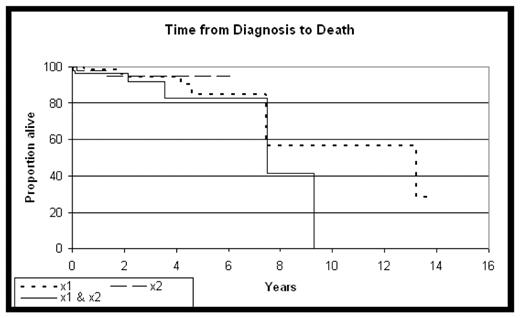Abstract
Background: An isolated 13q deletion in patients with chronic lymphocytic leukemia (CLL) is the single most common cytogenetic abnormality and is a favorable prognostic parameter (
Methods: We identified patients diagnosed with CLL between October 1992 to May 2008 and who had 13q deletion as their sole FISH abnormality. FISH was performed within 2 years of diagnosis and prior to treatment in all patients. Patients were sorted into three groups: 13q-x1 only, 13q-x2 only, or mosaic with both 13q-x1 and 13q-x2 cells. We assessed differences in percentage of abnormal cells, demographic characteristics, and clinical outcome among the three groups.
Results: We identified 259 patients with isolated 13q deletion. Age ranged from 38 to 90 years (median=61) and included 99 women and 160 men. With respect to Rai stage, 142 patients (60%) had low risk [Rai 0], 81 (34%) intermediate risk [Rai I-II], and 13 (6%) high risk [Rai III-IV] disease. After a median follow-up of 1.9 years, 40 patients (15%) have been treated and 17 (7%) have died. Median TFS and OS for all patients were 6.9 and 9.3 years, respectively. The mean percentage of abnormal nuclei in the three groups was 44%, 53%, and 47% for 13q-x1 only, mosaic 13q-x1/13q-x2, or 13q-x2 only, respectively (p=0.22). No significant difference in age or gender was observed based on whether 13q- occurred as a heterozygous or homozygous deletion, or was mosaic. Likewise, no significant difference in survival (p=0.313, see Table) or time to treatment (p=0.53) was found among the three groups. Five year OS rates for the 13q- x1 only, 13q- x2 only, and mosaic 13q- x1/13q- x2 are 85%, 95%, and 83%, respectively Median time to treatment for 13q-x1 was not reached, and for the mosaic13q-x1/13q-x2 and 13q-x2 groups median time to treatment was 6.9 and 4.9 years, respectively.
Conclusions: The presence of deletion in one versus two 13q- chromosomes in CLL patients appears to have no significant impact on treatment free or overall survival. This observation supports the grouping of CLL patients with isolated 13q- of one or both alleles into a single risk category as originally proposed in the risk categorization by Dohner et al. Taking the present findings together with those of Dohner et al and Dewald et al, we propose a hierarchical risk model of FISH abnormalities in CLL as 17p- à 11q- à 6q- à +12 à normal à 13q-, from most to least aggressive. The 13q- group would now include 13q-x1, 13q-x2, and the mosaic subgroups.
Disclosures: No relevant conflicts of interest to declare.
Author notes
Corresponding author


